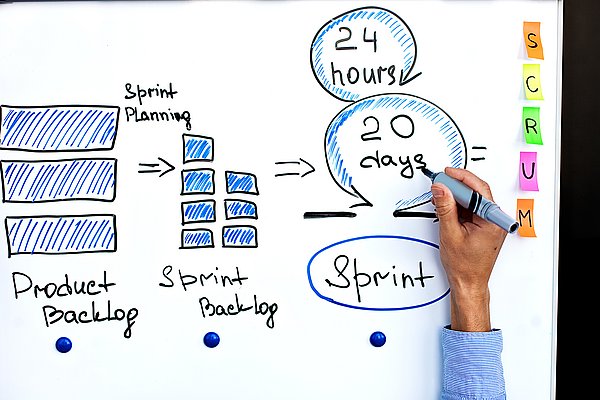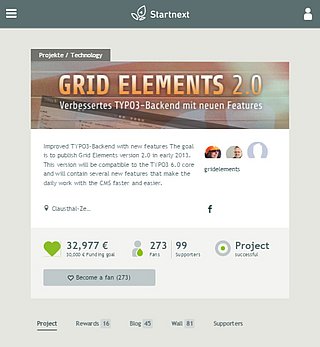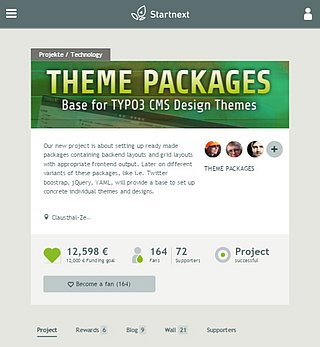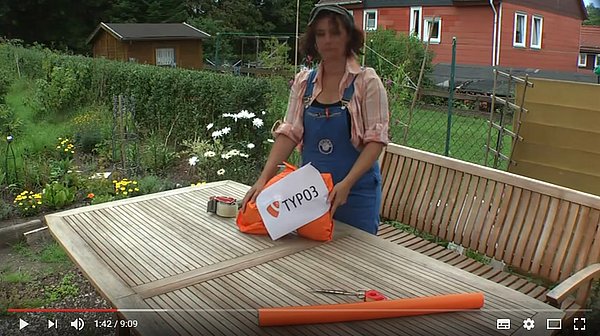Many a little makes a mickle

7 pros and cons of crowdfunding open-source
With crowdfunding as a very successful way for products or projects to collect money from the masses we are going to illuminate the pros and cons of this financing method regarding open-source plugins.
Estimated time to read: 6 minutes
Crowdfunding
Many a little makes a mickle
In 2012 with the TYPO3 association having become the major funding source for the TYPO3 core and other teams as well as the NEOS project, which was still around then, we needed some other ways to finance extension development. This is when crowdfunding came into play, since it was a way to collect money for clearly defined goals from a clearly defined target group.
While the revolution will be certainly televised, it strikes me that there is a strong possibility that the revolution will also be crowd-funded.
The Gridelements 2.0 refactoring was one of the first officially crowdfunded extension projects in the TYPO3 universe, raising an amount of 32,000.- € for paid development within a 90 day campaign on the crowd funding platform Startnext.
Since the Gridelements campaign had been quite favorable and was presented as a role model at several TYPO3 events, other TYPO3 related projects followed, with some of them being successfully funded, like the TYPO3 Theme Packages or TYPO3 mask in 2014. The latest TYPO3 project, which was sucessfully funded was the 50,000.- € frontend editing campaign done in 2016 by Swedish company Pixelant.
While there are several advantages for the crowd as a funder of extension development, there are some drawbacks as well. The clearly defined goals, the money being held in trust, the shortened time frame compared to association budgets, they all make crowdfunding an interesting choice. Still some projects miserably failed to reach their funding goal.
So there must be some pitfalls too, which is why we should take a closer look at this topic in this article.
Most troublesome is the legalization of crowd funding, the ability of start-up companies to raise capital from small investors on the Internet.
1 - The Crowd
Pro: Even small amounts count due to a supporting crowd
One of the good things about crowd funding is the fact that according to the saying 'many a little makes a mickle' even people who want to spend just small amounts can be considered as investors.
Con: A real crowd needs a critical mass to work
The smaller the community or target group you are aiming for, the more likely your crowd funding campaign will fail, since it needs a critical mass of possible backers who are interested in your product. So it might be harder to crowd-fund a TYPO3 extension than a Wordpress plugin.

2 - The Campaign
Pro: Marketing campaign for your product is included
Most of the crowd funding platforms like Kickstarter or Startnext, which we used for Gridelements and Themes, expect a more or less professionally produced campaign always including a video. So the good thing is, you get more marketing than the usual extension developer.
Con: Producing the campaign eats up the budget
The more professional you want your campaign to be, the more money it will take in advance to create it. Campaigns like the one for TYPO3 mask for example just raised enough money to get back the production costs, but actually you want the money for the product not the campaign.
3 - The Goals
Pro: Clearly defined goals for the backers
A good thing for the investors of the crowd is that they get clearly defined goals they can pick for a certain amount of payment. So they can provide money for something they really want in their TYPO3 extension while skipping the nice to have features.
Con: You are forced to create items for sale
Being forced to create items for sale contradicts modern principles of agile software development, since it will put you as a developer in the situation that you will have to deliver certain features even though they might turn out to be completely useless or unachievable during the development phase.

4 - The Account in Trust

Pro: Money being held in trust until the end of the campaign
Since people might not know you in person, it is a good thing to have trusted and professional partners like Kickstarter or Startnext who will keep the money on a trusted bank account until the end of the campaign.
Con: You don't reach the goal you won't get the money
One of the most annoying things about crowd funding is the fact that it is using gamification principles to motivate people to help you reach the goal. So you need to reach that predefined goal by winning the race within a certain time frame, otherwise you won't get the money.
5 - The Time
Pro: Shortened time frame compared to association budgets
While the association budgets we have been talking about in our previous post will be credited just once a year, you can start your own crowd funding campaign whenever you like and you don't have to wait for approval by the board or some other committee. Still you will get a kind of voting by your target group.
Con: Still too long for a monthly paycheck
An everage crowd funding campaign takes several weeks to run and might still not reach the funding goal in the end. Of course there have been outstanding campaigns, that reached their goal within just a few days, but usually you won't get a regular monthly paycheck out of crowd funding campaigns.

6 - The Drive

Pro: You gain a lot of momentum for a startup
Crowd funding campaigns have proven to be reasonable tools to raise money to kickstart start up companies, product launches and cultural projects. People even raised more than a million $ for their kickstarter campaign and their products became a huge success.
Con: After initial funding you will depend on other sources
The major problem people doing kickstarter campaigns tend to forget is the fact that running a business is not just about raising money for the start up. It will need a lot more money to keep that business running and in most of the cases this money has to come from other sources than crowd funding.
7 - The Follow-Up
Pro: You stay in close contact with your backers
As any other usual investor, people backing your product or service via crowd funding want to be informed. This is a good way to stay in contact with possible clients and to generate the business you will need to keep your product alive after your funding goal has been spent.
Con: You have to write a lot of additional documentation
You should never underestimate the amount of time you will have to invest to write documentation, news, blog articles and other information for your backers. Managing the communcation of a crowd funding campaign can easily become a full-time position.

TL;DR - Conclusion
Crowdfunding can generate a lot of money for a kick-start, but is it sustainable?
While crowdfunding worked out quite well for some projects in the TYPO3 ecosystem, other campaigns failed, since they did not fulfill the requirements for a successful campaign.
You need enough people who are interested in your service or product and trust you as a developer, a well prepared marketing campaign as well as defined items for sale and a professional communication.
Still crowd funding will not provide you with a regular income even when you reached the funding goal, since the TYPO3 community is too small to generate amounts that you might have heard of on Kickstarter and other platforms.
As a rough estimate there will be potential for one or two of these TYPO3 related campaigns per year, so the conclusion is, that we will need other solutions to generate a reliable income.
© Copyright 2025 Cybercraft GmbH









 Coders.Care is the logical progression of the cooperation between providers of TYPO3 extensions and their users. Especially the point of communication during the preparation of a project will be optimized thereby. The developers can focus on their strenghts, while Coders.Care deals with questions, answers and management. In the consequence there will be clear statements about maintenance and further development of TYPO3 extensions, so the trust in TYPO3 and the projects implemented with it will be strengthened. As a TYPO3 agency we can only benefit of such a service.
Coders.Care is the logical progression of the cooperation between providers of TYPO3 extensions and their users. Especially the point of communication during the preparation of a project will be optimized thereby. The developers can focus on their strenghts, while Coders.Care deals with questions, answers and management. In the consequence there will be clear statements about maintenance and further development of TYPO3 extensions, so the trust in TYPO3 and the projects implemented with it will be strengthened. As a TYPO3 agency we can only benefit of such a service.